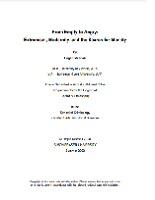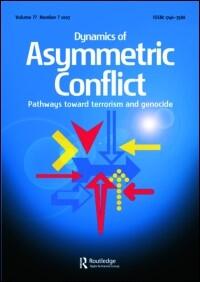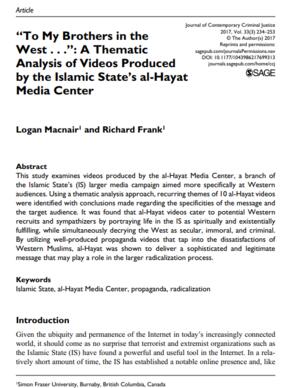Frank, Richard
Person Preferred Name
Richard Frank
Related Works
Content type
Digital Document
Abstract
An increase in the amount of high-profile incidents and attacks in the West perpetrated by individuals subscribing to a variety of extremist ideologies over the past decade has led to an influx of academic research concerned with uncovering how and why it is that individuals become radicalized toward ideologically-motivated extremist violence. While such research has examined a diverse range of social, demographic, and psychological variables and their potential link/correlation to the radicalization process, there has yet to emerge an accurate or reliable ‘profile’ with respect to who is more or less likely to become radicalized or join extremist/terrorist movements. The primary aim of this dissertation is to present a novel theoretical approach which centers the concept of individual identity as the fundamental factor which drives individuals in the West toward involvement with extremist movements. This theory of identity, which presupposes that macro-level structural factors fundamentally dictate how individuals experience and internalize identity on a micro-level, is outlined by tracing how the concept of ‘identity’ has historically evolved in ‘Western’ culture up to its current iteration in modern, hyper-connected, late-capitalist society. Once outlined, this theory of identity is empirically applied to the digital media content of two extremist movements via a mixed-method approach that utilizes topic modelling, sentiment analysis, and thematic/discourse analysis. More specifically, the content of the so-called Islamic State (including videos, magazines, and Twitter posts) and the user-generated comments of the notorious far-right online community r/The_Donald are examined through this theoretical lens and analyzed with this mixed-method approach. Results indicate that, wittingly or not, modern extremist movements routinely incorporate questions of identity into both their propaganda and general discussions in a manner that provides simplistic solutions and answers to the complex problems of identity and self that are created and amplified within modern Western culture. As such, this dissertation argues that the attraction of extremist ideology and the potential for extremist violence is, at current, an inevitable byproduct of modern macro-level structural and economic conditions.
Origin Information
Content type
Digital Document
Abstract
This article presents a case study of the recently conceived and ongoing counter-extremism campaign, Voices Against Extremism, a campaign designed and implemented by university students from Vancouver, Canada. Through a multifaceted approach that includes extensive use of social media, academic research, and grassroots community activities and involvement, Voices Against Extremism operates under the mission statement of countering and preventing violent extremism and radicalization through the humanization of minority groups and through the education and engagement of the silent majority. This article examines the effectiveness of this campaign as a proactive counter-radicalization strategy by outlining its specific components and activities. Based on the results of this campaign, suggestions are then offered regarding specific counter-extremism and counter-radicalizations policies that may be adopted by law enforcement, policymakers – or any other organizations concerned with countering and preventing radicalization and violent extremism – with a specific focus on the potential benefits of proactive and long-term social and community engagement.
Origin Information
Content type
Digital Document
Abstract
This study applies the semi-automated method of sentiment analysis in order to examine any quantifiable changes in the linguistic, topical, or narrative patterns that are present in the English-language Islamic State-produced propaganda magazines Dabiq (15 issues) and Rumiyah (10 issues). Based on a sentiment analysis of the textual content of these magazines, it was found that the overall use of language has remained largely consistent between the two magazines and across a timespan of roughly three years. However, while the majority of the language within these magazines is consistent, a small number of significant changes with regard to certain words and phrases were found. Specifically, the language of Islamic State magazines has become increasingly hostile towards certain enemy groups of the organization, while the language used to describe the Islamic State itself has become significantly more positive over time. In addition to identifying the changes and stabilities of the language used in Islamic State magazines, this study endeavours to test the effectiveness of the sentiment analysis method as a means of examining and potentially countering extremist media moving forward.
Origin Information
Content type
Digital Document
Abstract
This study applies the method of sentiment analysis to the online media released by the Islamic State (IS) in order to distinguish the ways in which IS uses language within their media, and potential ways in which this language differs across various online platforms. The data used for this sentiment analysis consist of transcripts of IS-produced videos, the text of IS-produced online periodical magazines, and social media posts from IS-affiliated Twitter accounts. It was found that the language and discourse utilised by IS in their online media is of a predominantly negative nature, with the language of videos containing the highest concentration of negative sentiment. The words and phrases with the most extreme sentiment values are used as a starting point for the identification of specific narratives that exist within online IS media. The dominant narratives discovered with the aid of sentiment analysis were: 1) the demonstrated strength of the IS, 2) the humiliation of IS enemies, 3) continuous victory, and 4) religious righteousness. Beyond the identification of IS narratives, this study serves to further explore the utility of the sentiment analysis method by applying it to mediums and data that it has not traditionally been applied to, specifically, videos and magazines.
Origin Information
Content type
Digital Document
Abstract
This study examines videos produced by the al-Hayat Media Center, a branch of the Islamic State’s (IS) larger media campaign aimed more specifically at Western audiences. Using a thematic analysis approach, recurring themes of 10 al-Hayat videos were identified with conclusions made regarding the specificities of the message and the target audience. It was found that al-Hayat videos cater to potential Western recruits and sympathizers by portraying life in the IS as spiritually and existentially fulfilling, while simultaneously decrying the West as secular, immoral, and criminal. By utilizing well-produced propaganda videos that tap into the dissatisfactions of Western Muslims, al-Hayat was shown to deliver a sophisticated and legitimate message that may play a role in the larger radicalization process.
Origin Information
Content type
Digital Document
Abstract
Originally presented in the 2012 European Intelligence and Security Informatics Conference (Odense, Denmark; 22-24 August 2012).
Crime Pattern Theory argues that offenders often commit their crimes at major criminal attractors or along the routes that lead to these attractors from other activity nodes in their awareness space. Without knowledge about each offender's awareness space, however, it is not possible to know the nodes they travel to. In this paper, it is assumed that each offender commits their crime along the way to a particular end-destination that they frequent. It thus follows that, for each crime location of an offender, there is an activity path nearby which starts at the offender's home location and ends at a nearby activity node. Since the activity node is not known, but the crime and home locations of offenders are, the method presented in this paper determines the locations of the attractors by statistically extending the path along the road-network from the offender's home location to their crime location. Each offender's movement pattern is based on probabilities assigned to each road segment that are determined by examining the angle of the road in relation to an offender's journey from home, and how frequently the road segment is taken by commuters on the road network. After generating paths for all offenders, attractor locations are identified by calculating the most frequently travelled nodes in the network. The aim of the model is to investigate the influence that crime attractors and other major activity nodes have on the locations of crimes to better understand the target selection behaviour of known offenders.
Origin Information
Content type
Digital Document
Abstract
Originally appeared in the 2011 European Intelligence and Security Informatics Conference (12-14 September 2011, Athens, Greece).
<p>In the current study we develop a Criminal Movement Model (CriMM) to investigate the relationship between simulated travel routes of offenders along the physical road network and the actual locations of their crimes in the same geographic space. With knowledge of offenders' home locations and the locations of major attractors, we are able to model the routes that offenders are likely to take when travelling from their home to an attractor by employing variations of Dijkstra's shortest path algorithm. With these routes plotted, we then compare them to the locations of crimes committed by the same offenders. This model was applied to five attractor locations within the Greater Vancouver Regional District (GVRD) in the province of British Columbia, Canada. Information about offenders in these cities was obtained from five years worth of real police data. After performing a small-scale analysis for each offender to investigate how far off their shortest path they go to commit crimes, we found that a high percentage of crimes were located along the paths taken by offenders in the simulations. Aggregate analysis was also performed to observe travel patterns in different areas of the cities and how they relate to the amount of crime in each neighbourhood. The results are discussed in relation to both theory and potential policy implications.
Origin Information
Content type
Digital Document
Abstract
Originally appeared in the 2013 IEEE International Conference on Intelligence and Security Informatics (4-7 June 2013; Seattle, WA, USA).
<p>Social network analysis refers to the study of structural aspects in networks to understand and interpret social entities and related patterns. This form of research has proven to be very useful in the study of illicit networks. To date, however, large criminal court datasets that include a comprehensive scope of cases have yet to be explored. The current work begins to explore this potential by applying social network analysis methods to CourBC-an extensive multi-year database of adult criminal court records in the Province of British Columbia, Canada. Through a variety of network analysis methods, the authors explore the topology and structure of the database. Results demonstrate that the structure of the dataset is similar to that of other large criminal justice datasets yet there are some notable differences. The potential for this type of data in illicit network research and some specific areas for continued research in the field are discussed.
Origin Information
Content type
Digital Document
Abstract
Book Chapter: There are many complex phenomena in the criminal justice system that are difficult to understand because they contain features or concepts that are fuzzy in nature; in other words, it is difficult to assign a crisp value or label to them. Fuzzy Logic is a mathematical concept developed to deal with these very problems. Fuzzy Logic techniques are capable of dealing with approximate facts and partial truths, and not just precise values to model complex issues and processes. While Fuzzy Logic has been used in a number of criminology and criminal justice research efforts, it has not been applied to issues in the criminal court system. Case management is critical to ensure court systems run efficiently and understanding case complexity is an important part of that task. In this chapter we propose Fuzzy Logic as a technique that could be used to model the complexity of cases using general characteristics that are known before cases enter the court system. Using the adult criminal court system in British Columbia as an example, we propose a model that could predict case complexity immediately following the laying of charges by Crown prosecutors. By understanding case complexity a priori, courts may be able to enhance early case consideration procedures such as screening and scheduling to create a more effective and efficient justice system.
<p>Book: Research into social systems is challenging due to their complex nature. Traditional methods of analysis are often difficult to apply effectively as theories evolve over time. This can be due to a lack of appropriate data, or too much uncertainty. It can also be the result of problems which are not yet understood well enough in the general sense so that they can be classified, and an appropriate solution quickly identified. Simulation is one tool that deals well with these challenges, fits in well with the deductive process, and is useful for testing theory. This field is still relatively new, and much of the work is necessarily innovative, although it builds upon a rich and varied foundation. There are a number of existing modelling paradigms being applied to complex social systems research. Additionally, new methods and measures are being devised through the process of conducting research.
We expect that readers will enjoy the collection of high quality research works from new and accomplished researchers.
<p>Book Series "Intelligent Systems Reference Library": The aim of this series is to publish a Reference Library, including novel advances and developments in all aspects of Intelligent Systems in an easily accessible and well structured form. The series includes reference works, handbooks, compendia, textbooks, well-structured monographs, dictionaries, and encyclopedias. It contains well integrated knowledge and current information in the field of Intelligent Systems. The series covers the theory, applications, and design methods of Intelligent Systems. Virtually all disciplines such as engineering, computer science, avionics, business, e-commerce, environment, healthcare, physics and life science are included. The list of topics spans all the areas of modern intelligent systems such as: Ambient intelligence, Computational intelligence, Social intelligence, Computational neuroscience, Artificial life, Virtual society, Cognitive systems, DNA and immunity-based systems, e-Learning and teaching, Human-centred computing and Machine ethics, Intelligent control, Intelligent data analysis, Knowledge-based paradigms, Knowledge management, Intelligent agents, Intelligent decision making, Intelligent network security, Interactive entertainment, Learning paradigms, Recommender systems, Robotics and Mechatronics including human-machine teaming, Self-organizing and adaptive systems, Soft computing including Neural systems, Fuzzy systems, Evolutionary computing and the Fusion of these paradigms, Perception and Vision, Web intelligence and Multimedia.
Origin Information
Content type
Digital Document
Abstract
The spatial distribution of crime has been a long-standing interest in the field of criminology. Research in this area has shown that activity nodes and travel paths are key components that help to define patterns of offending. Little research, however, has considered the influence of activity nodes on the spatial distribution of crimes in crime neutral areas - those where crimes are more haphazardly dispersed. Further, a review of the literature has revealed a lack of research in determining the relative strength of attraction that different types of activity nodes possess based on characteristics of criminal events in their immediate surrounds. In this paper we use offenders' home locations and the locations of their crimes to define directional and distance parameters. Using these parameters we apply mathematical structures to define rules by which different models may behave to investigate the influence of activity nodes on the spatial distribution of crimes in crime neutral areas. The findings suggest an increasing likelihood of crime as a function of geometric angle and distance from an offender's home location to the site of the criminal event. Implications of the results are discussed.
Origin Information






